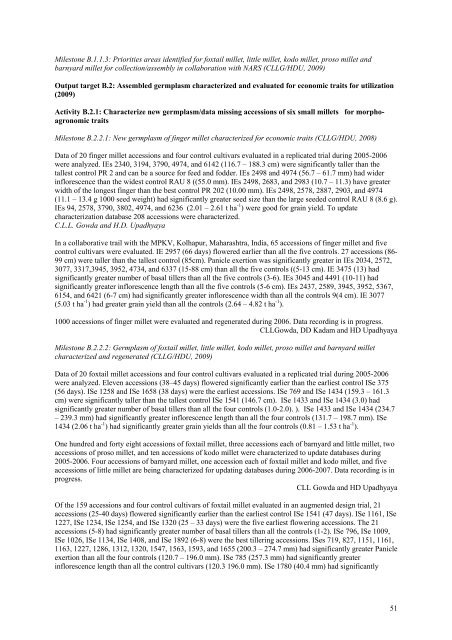ICRISAT Archival Report 2006 - The seedlings of success in the ...
ICRISAT Archival Report 2006 - The seedlings of success in the ...
ICRISAT Archival Report 2006 - The seedlings of success in the ...
Create successful ePaper yourself
Turn your PDF publications into a flip-book with our unique Google optimized e-Paper software.
Milestone B.1.1.3: Priorities areas identified for foxtail millet, little millet, kodo millet, proso millet and<br />
barnyard millet for collection/assembly <strong>in</strong> collaboration with NARS (CLLG/HDU, 2009)<br />
Output target B.2: Assembled germplasm characterized and evaluated for economic traits for utilization<br />
(2009)<br />
Activity B.2.1: Characterize new germplasm/data miss<strong>in</strong>g accessions <strong>of</strong> six small millets for morphoagronomic<br />
traits<br />
Milestone B.2.2.1: New germplasm <strong>of</strong> f<strong>in</strong>ger millet characterized for economic traits (CLLG/HDU, 2008)<br />
Data <strong>of</strong> 20 f<strong>in</strong>ger millet accessions and four control cultivars evaluated <strong>in</strong> a replicated trial dur<strong>in</strong>g 2005-<strong>2006</strong><br />
were analyzed. IEs 2340, 3194, 3790, 4974, and 6142 (116.7 – 188.3 cm) were significantly taller than <strong>the</strong><br />
tallest control PR 2 and can be a source for feed and fodder. IEs 2498 and 4974 (56.7 – 61.7 mm) had wider<br />
<strong>in</strong>florescence than <strong>the</strong> widest control RAU 8 ((55.0 mm). IEs 2498, 2683, and 2983 (10.7 – 11.3) have greater<br />
width <strong>of</strong> <strong>the</strong> longest f<strong>in</strong>ger than <strong>the</strong> best control PR 202 (10.00 mm). IEs 2498, 2578, 2887, 2903, and 4974<br />
(11.1 – 13.4 g 1000 seed weight) had significantly greater seed size than <strong>the</strong> large seeded control RAU 8 (8.6 g).<br />
IEs 94, 2578, 3790, 3802, 4974, and 6236 (2.01 – 2.61 t ha -1 ) were good for gra<strong>in</strong> yield. To update<br />
characterization database 208 accessions were characterized.<br />
C.L.L. Gowda and H.D. Upadhyaya<br />
In a collaborative trail with <strong>the</strong> MPKV, Kolhapur, Maharashtra, India, 65 accessions <strong>of</strong> f<strong>in</strong>ger millet and five<br />
control cultivars were evaluated. IE 2957 (66 days) flowered earlier than all <strong>the</strong> five controls. 27 accessions (86-<br />
99 cm) were taller than <strong>the</strong> tallest control (85cm). Panicle exertion was significantly greater <strong>in</strong> IEs 2034, 2572,<br />
3077, 3317,3945, 3952, 4734, and 6337 (15-88 cm) than all <strong>the</strong> five controls ((5-13 cm). IE 3475 (13) had<br />
significantly greater number <strong>of</strong> basal tillers than all <strong>the</strong> five controls (3-6). IEs 3045 and 4491 (10-11) had<br />
significantly greater <strong>in</strong>florescence length than all <strong>the</strong> five controls (5-6 cm). IEs 2437, 2589, 3945, 3952, 5367,<br />
6154, and 6421 (6-7 cm) had significantly greater <strong>in</strong>florescence width than all <strong>the</strong> controls 9(4 cm). IE 3077<br />
(5.03 t ha -1 ) had greater gra<strong>in</strong> yield than all <strong>the</strong> controls (2.64 – 4.82 t ha -1 ).<br />
1000 accessions <strong>of</strong> f<strong>in</strong>ger millet were evaluated and regenerated dur<strong>in</strong>g <strong>2006</strong>. Data record<strong>in</strong>g is <strong>in</strong> progress.<br />
CLLGowda, DD Kadam and HD Upadhyaya<br />
Milestone B.2.2.2: Germplasm <strong>of</strong> foxtail millet, little millet, kodo millet, proso millet and barnyard millet<br />
characterized and regenerated (CLLG/HDU, 2009)<br />
Data <strong>of</strong> 20 foxtail millet accessions and four control cultivars evaluated <strong>in</strong> a replicated trial dur<strong>in</strong>g 2005-<strong>2006</strong><br />
were analyzed. Eleven accessions (38–45 days) flowered significantly earlier than <strong>the</strong> earliest control ISe 375<br />
(56 days). ISe 1258 and ISe 1658 (38 days) were <strong>the</strong> earliest accessions. ISe 769 and ISe 1434 (159.3 – 161.3<br />
cm) were significantly taller than <strong>the</strong> tallest control ISe 1541 (146.7 cm). ISe 1433 and ISe 1434 (3.0) had<br />
significantly greater number <strong>of</strong> basal tillers than all <strong>the</strong> four controls (1.0-2.0). ). ISe 1433 and ISe 1434 (234.7<br />
– 239.3 mm) had significantly greater <strong>in</strong>florescence length than all <strong>the</strong> four controls (131.7 – 198.7 mm). ISe<br />
1434 (2.06 t ha -1 ) had significantly greater gra<strong>in</strong> yields than all <strong>the</strong> four controls (0.81 – 1.53 t ha -1 ).<br />
One hundred and forty eight accessions <strong>of</strong> foxtail millet, three accessions each <strong>of</strong> barnyard and little millet, two<br />
accessions <strong>of</strong> proso millet, and ten accessions <strong>of</strong> kodo millet were characterized to update databases dur<strong>in</strong>g<br />
2005-<strong>2006</strong>. Four accessions <strong>of</strong> barnyard millet, one accession each <strong>of</strong> foxtail millet and kodo millet, and five<br />
accessions <strong>of</strong> little millet are be<strong>in</strong>g characterized for updat<strong>in</strong>g databases dur<strong>in</strong>g <strong>2006</strong>-2007. Data record<strong>in</strong>g is <strong>in</strong><br />
progress.<br />
CLL Gowda and HD Upadhyaya<br />
Of <strong>the</strong> 159 accessions and four control cultivars <strong>of</strong> foxtail millet evaluated <strong>in</strong> an augmented design trial, 21<br />
accessions (25-40 days) flowered significantly earlier than <strong>the</strong> earliest control ISe 1541 (47 days). ISe 1161, ISe<br />
1227, ISe 1234, ISe 1254, and ISe 1320 (25 – 33 days) were <strong>the</strong> five earliest flower<strong>in</strong>g accessions. <strong>The</strong> 21<br />
accessions (5-8) had significantly greater number <strong>of</strong> basal tillers than all <strong>the</strong> controls (1-2). ISe 796, ISe 1009,<br />
ISe 1026, ISe 1134, ISe 1408, and ISe 1892 (6-8) were <strong>the</strong> best tiller<strong>in</strong>g accessions. ISes 719, 827, 1151, 1161,<br />
1163, 1227, 1286, 1312, 1320, 1547, 1563, 1593, and 1655 (200.3 – 274.7 mm) had significantly greater Panicle<br />
exertion than all <strong>the</strong> four controls (120.7 – 196.0 mm). ISe 785 (257.3 mm) had significantly greater<br />
<strong>in</strong>florescence length than all <strong>the</strong> control cultivars (120.3 196.0 mm). ISe 1780 (40.4 mm) had significantly<br />
51

















